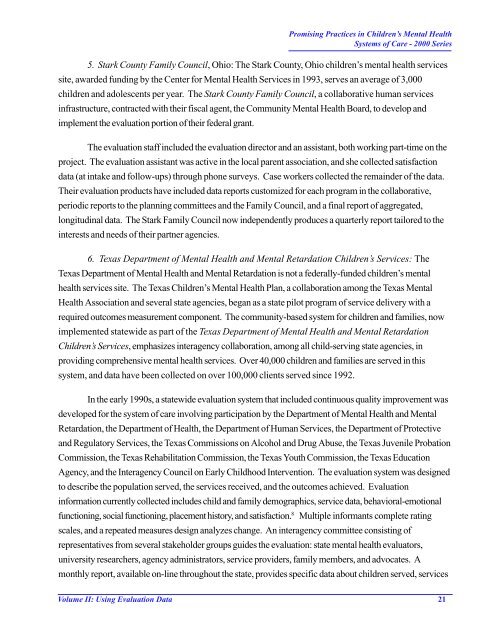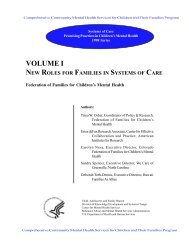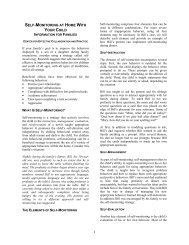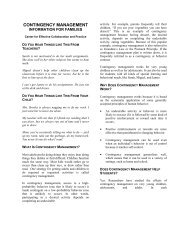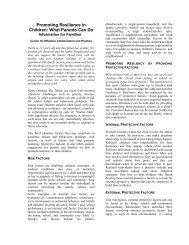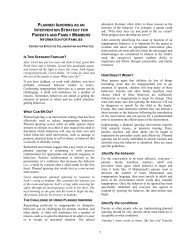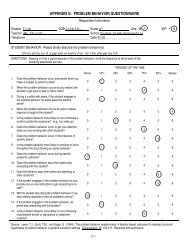Using evaluation data to manage, improve, market, and sustain ...
Using evaluation data to manage, improve, market, and sustain ...
Using evaluation data to manage, improve, market, and sustain ...
You also want an ePaper? Increase the reach of your titles
YUMPU automatically turns print PDFs into web optimized ePapers that Google loves.
Promising Practices in Children’s Mental Health<br />
Systems of Care - 2000 Series<br />
5. Stark County Family Council, Ohio: The Stark County, Ohio children’s mental health services<br />
site, awarded funding by the Center for Mental Health Services in 1993, serves an average of 3,000<br />
children <strong>and</strong> adolescents per year. The Stark County Family Council, a collaborative human services<br />
infrastructure, contracted with their fiscal agent, the Community Mental Health Board, <strong>to</strong> develop <strong>and</strong><br />
implement the <strong>evaluation</strong> portion of their federal grant.<br />
The <strong>evaluation</strong> staff included the <strong>evaluation</strong> direc<strong>to</strong>r <strong>and</strong> an assistant, both working part-time on the<br />
project. The <strong>evaluation</strong> assistant was active in the local parent association, <strong>and</strong> she collected satisfaction<br />
<strong>data</strong> (at intake <strong>and</strong> follow-ups) through phone surveys. Case workers collected the remainder of the <strong>data</strong>.<br />
Their <strong>evaluation</strong> products have included <strong>data</strong> reports cus<strong>to</strong>mized for each program in the collaborative,<br />
periodic reports <strong>to</strong> the planning committees <strong>and</strong> the Family Council, <strong>and</strong> a final report of aggregated,<br />
longitudinal <strong>data</strong>. The Stark Family Council now independently produces a quarterly report tailored <strong>to</strong> the<br />
interests <strong>and</strong> needs of their partner agencies.<br />
6. Texas Department of Mental Health <strong>and</strong> Mental Retardation Children’s Services: The<br />
Texas Department of Mental Health <strong>and</strong> Mental Retardation is not a federally-funded children’s mental<br />
health services site. The Texas Children’s Mental Health Plan, a collaboration among the Texas Mental<br />
Health Association <strong>and</strong> several state agencies, began as a state pilot program of service delivery with a<br />
required outcomes measurement component. The community-based system for children <strong>and</strong> families, now<br />
implemented statewide as part of the Texas Department of Mental Health <strong>and</strong> Mental Retardation<br />
Children’s Services, emphasizes interagency collaboration, among all child-serving state agencies, in<br />
providing comprehensive mental health services. Over 40,000 children <strong>and</strong> families are served in this<br />
system, <strong>and</strong> <strong>data</strong> have been collected on over 100,000 clients served since 1992.<br />
In the early 1990s, a statewide <strong>evaluation</strong> system that included continuous quality <strong>improve</strong>ment was<br />
developed for the system of care involving participation by the Department of Mental Health <strong>and</strong> Mental<br />
Retardation, the Department of Health, the Department of Human Services, the Department of Protective<br />
<strong>and</strong> Regula<strong>to</strong>ry Services, the Texas Commissions on Alcohol <strong>and</strong> Drug Abuse, the Texas Juvenile Probation<br />
Commission, the Texas Rehabilitation Commission, the Texas Youth Commission, the Texas Education<br />
Agency, <strong>and</strong> the Interagency Council on Early Childhood Intervention. The <strong>evaluation</strong> system was designed<br />
<strong>to</strong> describe the population served, the services received, <strong>and</strong> the outcomes achieved. Evaluation<br />
information currently collected includes child <strong>and</strong> family demographics, service <strong>data</strong>, behavioral-emotional<br />
functioning, social functioning, placement his<strong>to</strong>ry, <strong>and</strong> satisfaction. 8 Multiple informants complete rating<br />
scales, <strong>and</strong> a repeated measures design analyzes change. An interagency committee consisting of<br />
representatives from several stakeholder groups guides the <strong>evaluation</strong>: state mental health evalua<strong>to</strong>rs,<br />
university researchers, agency administra<strong>to</strong>rs, service providers, family members, <strong>and</strong> advocates. A<br />
monthly report, available on-line throughout the state, provides specific <strong>data</strong> about children served, services<br />
Volume II: <strong>Using</strong> Evaluation Data 21


